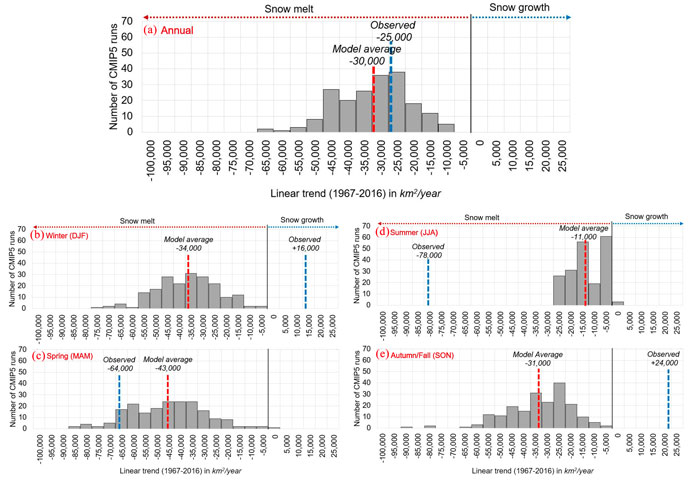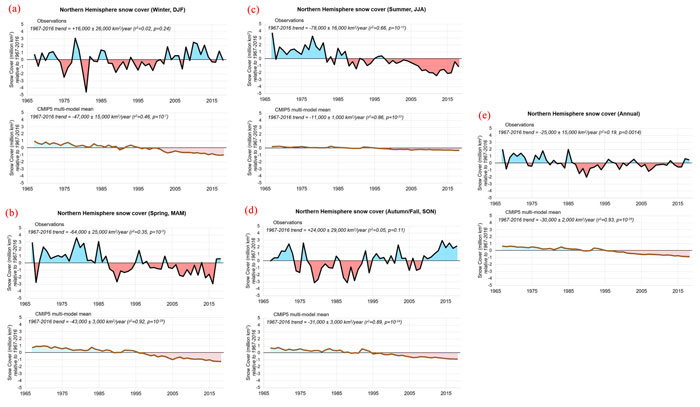Observed vs Predicted Trends in Northern Hemisphere Snow Cover
Paper Reviewed Connolly, R., Connolly, M., Soon, W., Legates, D.R., Cionco, R.G. and Herrera, V.M.V. 2019. Northern Hemisphere snow-cover trends (1967-2018): A comparison between climate models and observations. Geosciences 9: 135, doi:10.3390/geosciences9030135. In a revealing paper Connolly et al. (2019) investigated the accuracy of climate models utilized by the IPCC to predict future trends in Northern Hemisphere (NH) snow cover. Since the mid-1970s, model-based estimates have consistently predicted this parameter should be declining in response to supposed CO2-induced global warming. But is it? Connolly et al. address this question by examining observed changes in NH snow cover extent over the period 1967-2018 and then comparing them to changes predicted by 24 climate models (in a total of 196 model runs) from the Coupled Model Intercomparison Project Phase 5 (CMIP5). The five-decade study widow was selected because it represents the full duration of available satellite-derived records of NH snow cover. Results indicated that trends in annual NH snow cover were fairly similar when computed for both the observational record and as an average of all model runs — declines of 25,000 km2 yr-1 over the 52-year period for observations and 30,000 km2 yr-1 for the models (see Figure 1a). However, that is pretty much where the similarities end. As shown in Figure 1b-e, large discrepancies between models and observations exist when comparing snow cover trends by season. For spring and summer, the observed trends in snow cover decline were much stronger than that predicted by the model average: -64,000 km2 yr-1 (spring observations) vs -43,000 km2 yr-1 (spring model average) and -78,000 km2 yr-1 (summer observations) vs -11,000 km2 yr-1 (summer model average). In contrast, trends in snow cover for fall and winter were not just dissimilar in magnitude, they were opposite in sign; models predicted declines of -31,000 km2 yr-1 (fall) and -34,000 km2 yr-1 (winter), whereas observations revealed snow cover gains of +24,000 km2 yr-1 (fall) and +16,000 km2 yr-1 (winter). Beyond the discrepancies listed above, Connolly et al. go on to further demonstrate that the models fail to capture the nonlinearity inherent in the snow cover data. Figure 2 illustrates as much by presenting paired plots of observational and model-predicted snow cover values on a seasonal and annual time scale over the 52-year period of examination. As seen there, the model-predicted values fail to capture the variability and periodicities that exists in the observational data, instead showing continual declines in snow cover across the full length of the records. Connolly et al. conclude by offering several explanations as to why the models behave in such a manner that is inconsistent with the observational data. In concluding their paper, the researchers state the obvious, offering “we recommend that the climate model projections of future and past snow-cover trends should be treated with considerable caution and skepticism,” adding that “it is important that [policy makers] planning for future changes in snow cover do not rely on unreliable projections.” And that is good advice to end a very important and revealing study.
 Figure 1. Distribution of linear 1967-2016 Northern Hemisphere snow cover trends for 196 CMIP5 simulations for (a) winter, (b) spring, (c) summer, (d) autumn/fall, and (e) annual averages. The observed trends for each season (or yearly average) are indicated with dashed, blue lines in each panel. Source: Connolly et al. (2019).
Figure 1. Distribution of linear 1967-2016 Northern Hemisphere snow cover trends for 196 CMIP5 simulations for (a) winter, (b) spring, (c) summer, (d) autumn/fall, and (e) annual averages. The observed trends for each season (or yearly average) are indicated with dashed, blue lines in each panel. Source: Connolly et al. (2019). Figure 2. (a) Winter, (b) spring, (c) summer, (d) fall and (e) annually-averaged trends in Northern Hemisphere snow cover (relative to 1967-2016) according to observations and the CMIP5 multi-model mean. The uncertainty ranges associated with the linear trends correspond to twice the standard error associated with the linear fit. Source: Connolly et al. (2019).
Figure 2. (a) Winter, (b) spring, (c) summer, (d) fall and (e) annually-averaged trends in Northern Hemisphere snow cover (relative to 1967-2016) according to observations and the CMIP5 multi-model mean. The uncertainty ranges associated with the linear trends correspond to twice the standard error associated with the linear fit. Source: Connolly et al. (2019).